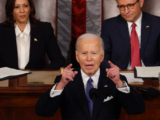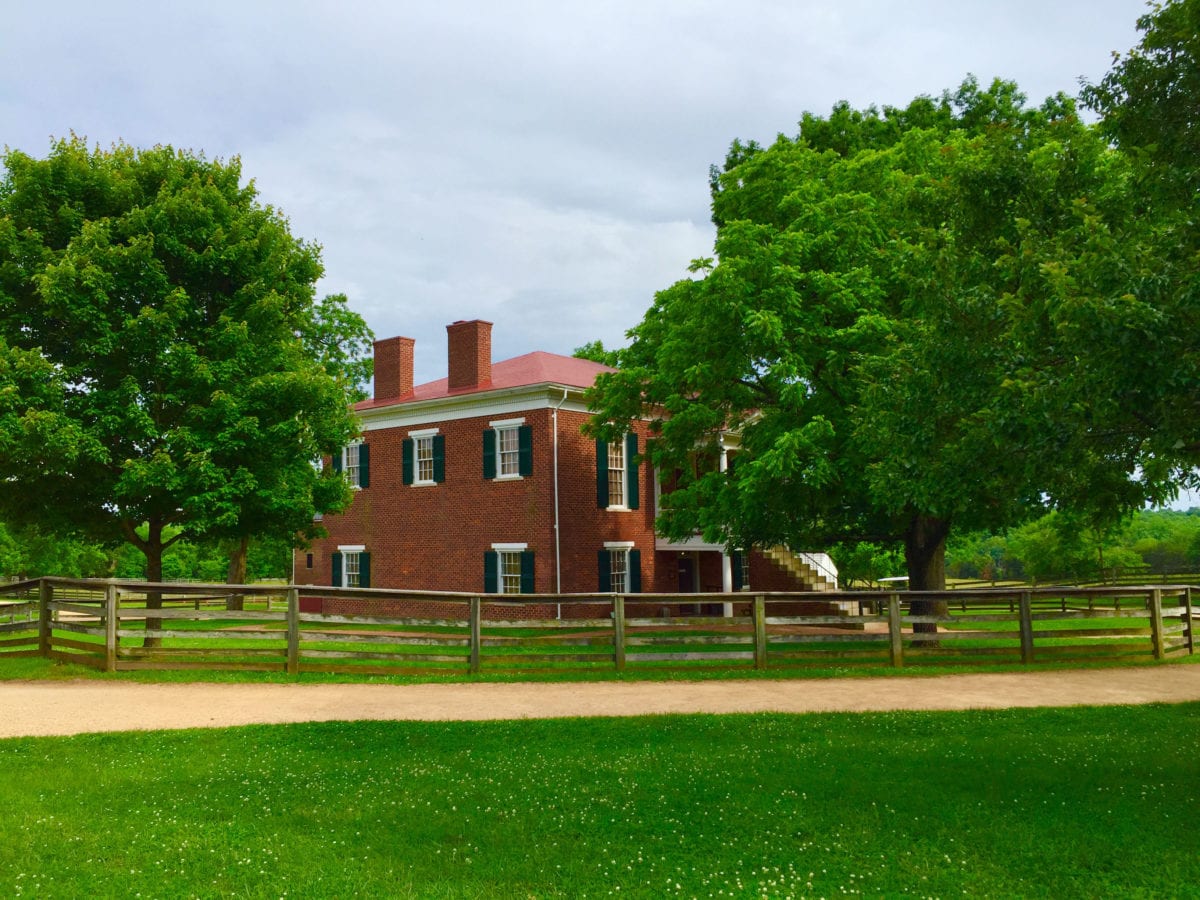
A view of the old courthouse in the preserved village of Appomattox Court House, Virginia: Glynn Wilson
By Glynn Wilson –
APPOMATTOX, Virg. — We didn’t make it here in time for Memorial Day, but National Park Service rangers and volunteers say nearly 500 people showed up for the playing of “Taps” and holiday weekend programs. I don’t know for sure, but considering that Confederate sympathizers seem to generate more engagement these days than Union supporters in public debates about the Civil War, I suspect a majority of those in the crowd were southerners who still feel something for the greatest lost cause in American history.
We arrived at the National Historic Park at Appomattox Court House late Wednesday afternoon with just enough time for a quick look around to snap a few photos. But the first curious question that came up was this: Why was the famous surrender of Confederate General Robert E. Lee and the Army of Northern Virginia to Union General U. S. Grant not actually held at the town courthouse?
This is a historical misconception that many Americans and tourists probably have, but part of the answer is simply semantics. At the time on April 9, 1865, the place chosen for the surrender ceremony was a village called Appomattox Court House, two words. There was and is a courthouse, one word, in the preserved village. It is now the visitors center (see above).
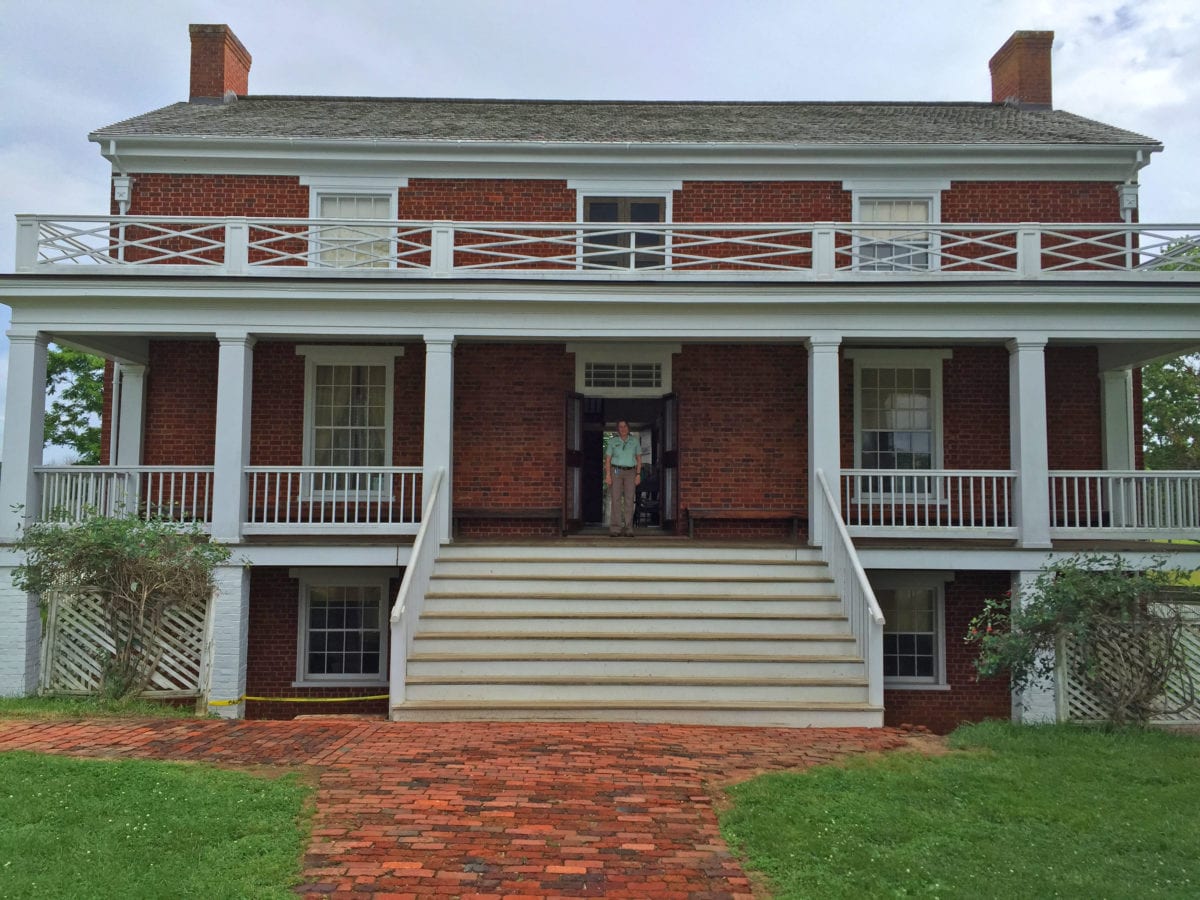
A view of the McClean House with a National Park Service volunteer where Lee’s surrender to Grant actually took place: Glynn Wilson
The famous surrender scene that has been depicted in paintings and film actually took place in the parlor, on the porch and in the yard of the McLean House, owned then by farmer Wilmer McLean. No actual photographs exist of the meeting between Lee and Grant here, as the story goes, because all the war reporters and photographers were down the road in Richmond covering the fire, the burning of that town. It’s too bad not one bright photojournalist had the foresight to tag along with Lee or Grant. We now have to rely on oral histories of what actually happened since no newspaper reporters or photographers were on the scene to document what went down, what was said.
According to the National Park Service, the “Gentlemen’s Agreement” to begin ending the war happened something like this.
On the morning of April 9, while General Robert E. Lee realized that the retreat of his beleaguered army had finally been halted, U. S. Grant was riding toward the village of Appomattox Court House where Union Cavalry, followed by infantry from the V, XXIV, and XXV Corps, had blocked the Confederate Army’s path. Lee sent a letter to Grant requesting a meeting to discuss his army’s surrender. The letter came to Grant and his party just before noon about four miles west of Walker’s Church (present-day Hixburg).
Grant, who had been suffering from a severe headache, later remembered that upon reading Lee’s letter the pain in his head disappeared. He stopped to prepare his reply to Lee, writing that he would push to the front to meet him.
The location of the meeting was left to Lee’s discretion. Lt. Colonel Orville E. Babcock and his orderly, Capt. Dunn, took Grant’s reply and rode ahead. Babcock found Lee resting under an apple tree near the Appomattox River. After reading Grant’s letter, Lee, his Aide-de-Camp Lt. Colonel Charles Marshall, and Private Joshua O. Johns rode toward Appomattox Court House accompanied by Federal Officers Lt. Col. Babcock and Capt. William McKee Dunn. Marshall and Johns rode ahead of Lee in order to find a place for the generals to confer.
As Marshall passed through the village he saw farmer Wilmer McLean in the vicinity of the courthouse, an odd fellow to run into considering he had been a witness to the first battle of the war at his farm in Manassas (or Bull Run depending on which side you were on). Figuring that being in the middle of the Civil War zone would not be good for commerce, McLean moved to Appomattox. So the war started and ended in his yard.
Anyway Marshall asked McLean if he knew of a suitable location for the two great generals to meet, and McLean took him to an empty building in the village with no furniture. Marshall rejected this offer. Then McLean offered his own farm house. After seeing the comfortable country surroundings, Marshall accepted and sent Private Johns back to inform General Lee that a meeting site had been found.
Lee arrived at the McLean house about 1 p.m. and took a seat in the parlor. A half hour later, the sound of horses on the stage road signaled the approach of General Grant. Entering the house, Grant greeted Lee in the center of the room. The generals presented a contrasting appearance; Lee in a new Confederate grey uniform and Grant in his mud-spattered Union blue field uniform.
Grant, who remembered meeting Lee once during the Mexican War, asked the Confederate general if he recalled their meeting. Lee replied that he did, and the two conversed in a very cordial manner for approximately 25 minutes. The subject had not yet gotten around to surrender until finally, Lee, supposedly feeling the anguish of defeat, brought Grant’s attention to the subject at hand.
Grant, who later confessed to being embarrassed at having to ask for the surrender from Lee, said simply that the terms would be just as he had outlined in a previous letter. The terms would parole officers and enlisted men but required that all Confederate military equipment be relinquished, including any long guns. The discussion between the generals then drifted into the prospects for peace, but Lee, once again taking the lead, asked Grant to put his terms in writing.
When Grant finished, he handed the terms to Lee, who donned his reading spectacles and quietly looked them over. When he finished reading, Lee looked up at Grant and reportedly said: “This will have a very happy effect on my army.”
Lee asked if the terms allowed his men to keep their horses, for in the Confederate army men owned their mounts. Lee explained that his men would need these animals to farm once they returned to civilian life. Grant responded that he would not change the terms as written (which had no provisions allowing private soldiers to keep their mounts) but would order his officers to allow any Confederate claiming a horse or a mule to keep it. General Lee agreed that this concession would go a long way toward promoting healing. Officers were also allowed to keep their side arms.
Grant’s generosity, as ordered by Lincoln, extended further. When Lee mentioned that his men had been without rations for several days, the Union commander arranged for 25,000 rations to be sent to the hungry southerners.
The rough draft of the terms was copied into ink by Lieutenant Colonel Ely Parker and signed by Grant before being passed to Lee. General Lee had Lieutenant Colonel Charles Marshall draft a letter accepting the terms of surrender, which Lee then signed and passed to Grant. At 3 p.m. the meeting concluded with a handshake.
The next day, April 10th, a second meeting of six officers, three Confederate and three Union, convened in the McLean parlor. The purpose of this “commissioners’ meeting” was to hammer out the details of the formal surrender ceremony and to define who was subject to the surrender.
“In a war that was marked by such divisiveness and bitter fighting, it is remarkable that it ended so simply,” according to the NPS. “Grant’s compassion and generosity (as ordered by President Abraham Lincoln) did much to allay the emotions of the Confederate troops. As for Lee, he realized that the best course was for his men to return home and resume their lives as American citizens.”
Before he met with General Grant, one of Lee’s officers (General E. Porter Alexander) had suggested fighting a guerilla war, but Lee had rejected the idea. It would only cause more pain and suffering for a cause that was clearly lost by then. The character of both Lee and Grant was of such a high order that the surrender of the Army of Northern Virginia has been called “The Gentlemen’s Agreement.”
Though not officially the end of the American Civil War, Lee’s surrender at Appomattox signaled the beginning of the end of the four year conflict. By June 1865, the remaining Confederate armies had surrendered and the war was over. The military defeat of the Confederacy, signaled by Lee’s surrender, began the long process of reunion and ensured the realization of #Emancipation for more than 3 million enslaved African Americans.
Of course the famous scene with Lee backing up on his horse Traveller in the yard of the McLean House and tipping his hat to Grant has been dramatized and depicted in a number of movies.
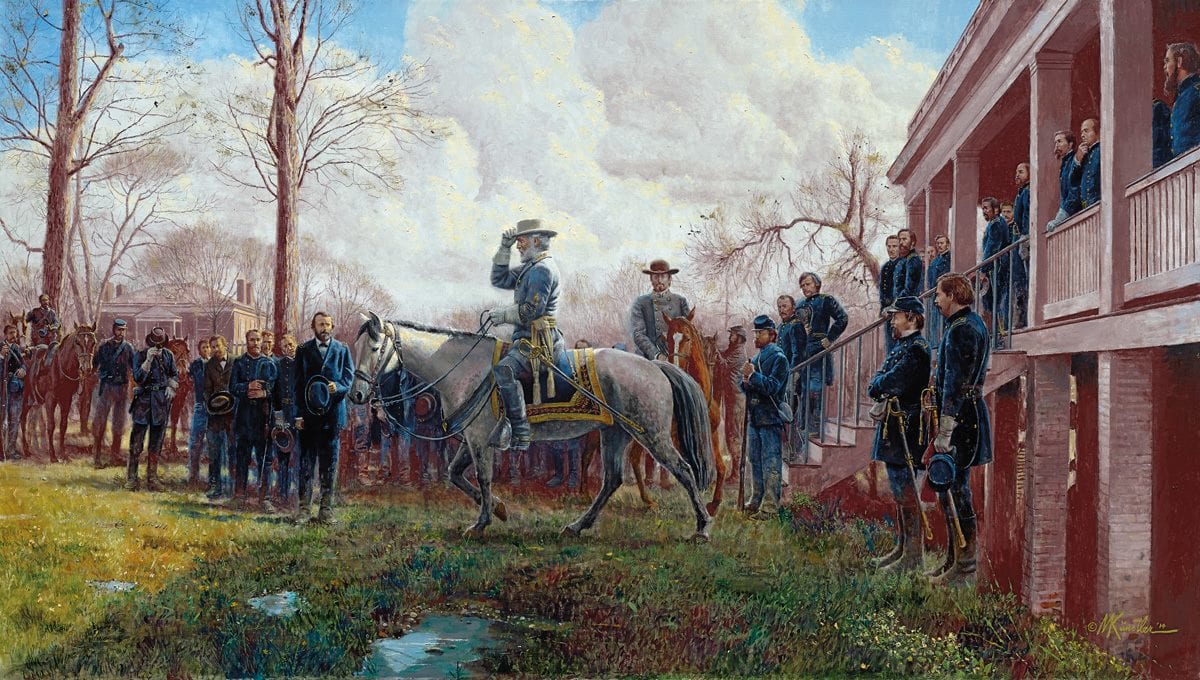
This Keith Rocco painting shows Gen. Lee exiting the yard of the McLean House after the famous surrender meeting with Gen. Grant: NPS
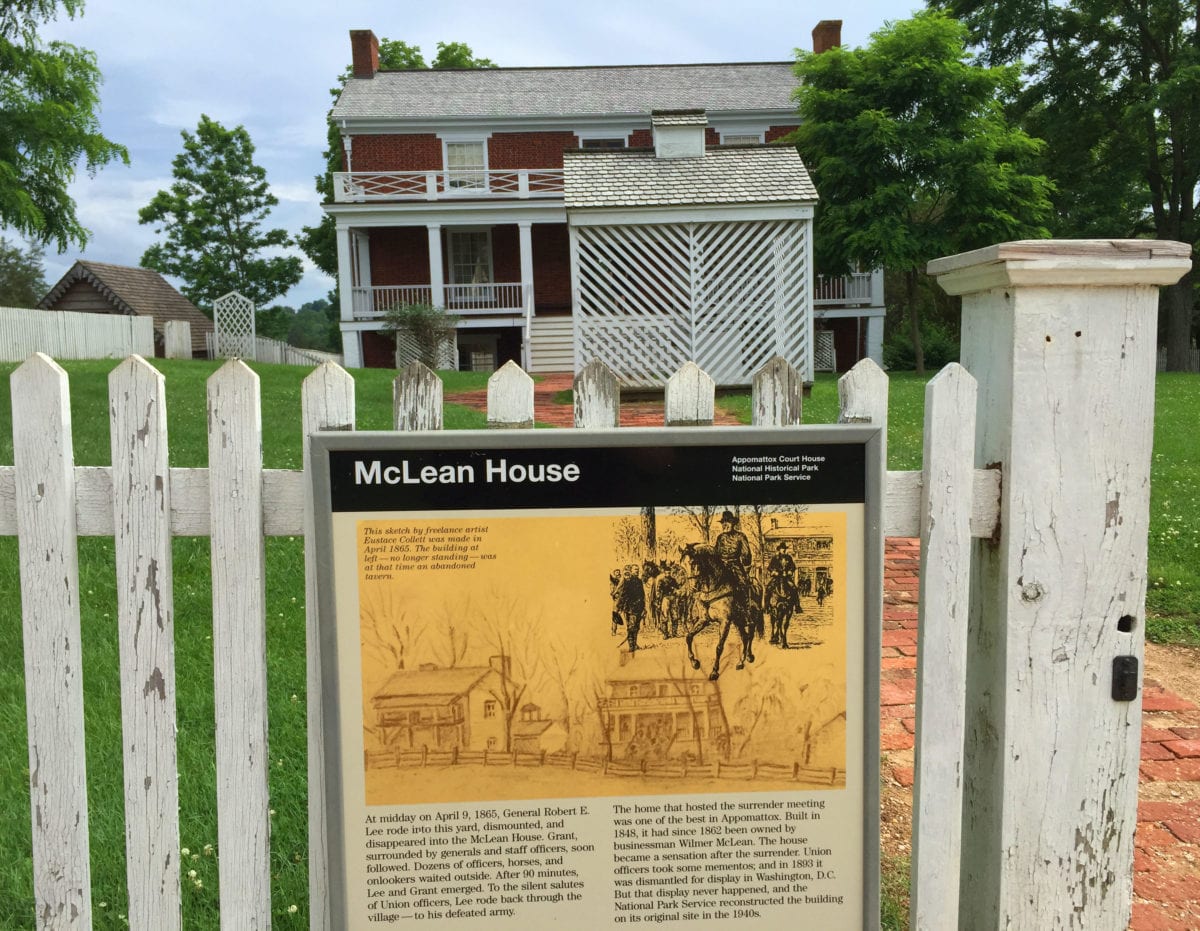
A view of the McClean House where Lee’s surrender to Grant actually took place: Glynn Wilson







